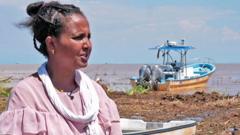As the sun dipped below Lake Turkana's horizon, Senait Mebrehtu wept, scattering blooms into the green-blue waters to honor her teenage daughter, Hiyab, who lost her life attempting to navigate treacherous migration paths. This dedicated mother, an Eritrean Pentecostal Christian, journeyed to north-western Kenya to grasp where her 14-year-old daughter drowned last year while venturing into Kenya alongside her sister, who was fortunate enough to survive.
"If the smugglers had warned me about the lake's dangers, I would never have allowed my daughters to embark on this perilous journey," Senait expressed, her voice thick with emotion as she recalled arriving in Nairobi three years ago under a tourist visa, fleeing the oppressive grip of religious persecution in Eritrea. Forced to leave two daughters behind due to fears of conscription, Senait faced an agonizing decision when they begged to join her, ultimately leading to a devastating outcome.
Consulting family members, she agreed to the smugglers, who transported the girls overland for weeks through Ethiopia and into Kenya, culminating at the northern shores of Lake Turkana. As the illegal crossings became more prevalent, one smuggler described this new route as "the digital route," emphasizing its risky and emergent nature. With ongoing patrols tightening on established routes, traffickers have begun leaning on the immense lake, where clandestine operations flourish.
Senait blamed the smugglers for the calamity, mentioning their negligence as the boat capsized from being overloaded. Witness Osman echoed her remarks, recalling the harrowing moment Hiyab's boat met its tragic fate, leading to multiple drownings. Local fishermen also confirmed sightings of migrant bodies, reflective of the lake's dangers.
The ongoing crisis has prompted hundreds of thousands from Eritrea to seek refuge elsewhere, propelled by governmental oppression and military instability. As neighboring countries become destinations for these migrants, smugglers exploit vulnerable families, engaging in ruthless trades often leading to hardship.
While some migrants find asylum in Kenya, others view it merely as a stepping stone towards other countries, drawn by perceptions of easier access to refugee status. Within holding houses in Nairobi, migrants endure dangerous conditions, with numerous cases of exploitation and survival depending on their financial means.
For Senait, the memory of her daughter remains heavy, alongside gratitude for the survival of her other child. “We share in the suffering that every Eritrean family bears,” she stated sadly. The desperation and emotional turmoil of those navigating the perilous world of migration remains a pressing concern, underscoring the need for systemic change and compassion.




















